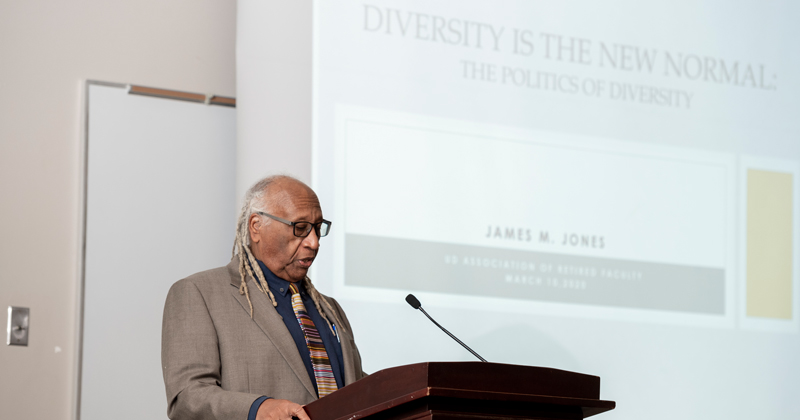


Conflicting arguments
Photo by by Kathy F. Atkinson March 30, 2020
Professor Emeritus James McCoy Jones discusses challenges of diversity
Racism is wrong. Clearly, objectively, patently wrong. Which means its opposite — embracing and promoting diversity — must be right.
Right?
According to James McCoy Jones, long-time faculty member and honored speaker at the March 10 luncheon of the University of Delaware Association of Retired Faculty (UDARF), this is a loaded question. Unlike racism (always condemnable) or rooting for the UD Blue Hens (always commendable), diversity is not a neatly defined moral absolute. It is far more nuanced than that.
“Diversity is one of these challenges where, if we do it right, we’ll be on a positive course,” said Jones, Trustees’ Distinguished Professor Emeritus of Psychological and Brain Sciences and Black American Studies. “But if we don’t, we’ll be facing very serious problems.”
This may sound subversive. Haven’t we as a society determined that diversity is our strength — no questions asked? You can now buy that catchphrase in the form of sweatshirts, refrigerator magnets and embroidered Pinterest pillows. It is woven into the mission statements of companies selling everything from software to sunscreen. It is increasingly the mantle of leaders in business and government. It is, by all indicators, the future.
So… what gives?
According to Jones, who directs UD’s Center for the Study of Diversity, in the public consciousness there are two conflicting arguments for diversity. Each is correct. Each is valid. Yet, these arguments are sometimes at odds with one another, and this is problematic.
One of these positions is the so-called moral argument: Diversity efforts are a way to acknowledge historic racism and ameliorate those effects. The other position is the instrumental argument: Diversification includes and benefits us all. In other words, as author Peter Wood wrote in the New Boston Post in 2015: “Diversity is both kumbaya and Black Lives Matter.”
This duality, Jones explained, “can foster confusion and conflict.”
Consider statements on diversity written by universities. Jones said 75 percent of these adopt the instrumental — or kumbaya — approach. There’s nothing wrong with this, per se, Jones said, except for what the research shows: Black students are less likely to graduate and more likely to perform poorly in schools that adopt the we-are-all-in-this-together attitude.
“Groups who are concerned with biases they must overcome feel unfulfilled — and at times disrespected — when they are lumped with other groups with very different histories,” Jones said. “The inclusive idea — that everyone is better for it — does not work in a world that is seen as a zero-sum contest for resources, prestige and opportunity.”
On the other hand, the moral approach to diversity that acknowledges our different histories? Research shows whites feel excluded from this and, when they feel excluded, they fail to support diversity efforts, he said. Sometimes, they actively or passively oppose them.
Put another way: “Inclusion as a concept is both a goal of diversity and a challenge it faces,” Jones said.
These difficulties are compounded by other factors. For starters, diversity encompasses much more than race. There are variations of sex, gender orientation, religion, ethnicity, age, sexual orientation and immigrant status to consider, among other factors. Within an institutional framework, it’s impossible to respond to them all. So, when formulating or analyzing diversity efforts, these differences get truncated into categories.
“Consider, for example, international students,” Jones said. “They may come from China, Southeast Asia, Japan, Middle East, Caribbean, South America and Africa, not to mention Europe. Considering this diversity of background, what does the international category even mean?”
Of course, these obstacles don’t take away from a research-backed truism: The more diverse we are at any level, the greater the gains in terms of learning and experience. The question, then, is not whether greater diversification should be attempted, but how to go about it in a meaningful way — one that goes beyond magnets and embroidered pillows.
For that, Jones explained, there must be constant negotiation and communication between groups. At both the institutional and personal levels, everyone must strive for openness when it comes to learning about and with others. And, in navigating this potentially tricky territory, we need to keep in mind, perhaps, the importance of understanding.
“Anthropologist Margaret Mead once likened people living in a post A-bomb world as pioneers,” Jones said. “I believe we are living in a post-diversity-explosion world, and we are all still learning how to do that….Yes, diversity is the new normal, but it is not yet normalized. It is still a work in progress.”
Contact Us
Have a UDaily story idea?
Contact us at ocm@udel.edu
Members of the press
Contact us at 302-831-NEWS or visit the Media Relations website

